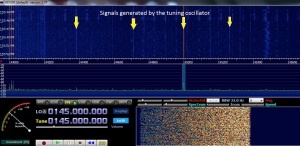Having a low to no budget for amateur radio gear, I did a lot of searching on what was available to just listen to the ham bands. After finding many receivers in the $100-$200 range I decided that it was more than I wanted to dump into a radio just to hear “bunion talk” (just my poke at how typical conversations gravitate toward physical ailments if not talking about gear).
Another search based on my “low budget, want to hear things” requirements lead me to seek out information on Software Defined Radio (SDR). Basically, software emulation of hardware components to reduce cost.
I found much information on the topic of acquiring and running the dongles that Europeans used to use to tune in their PAL TV channels on their computers, coupled with open or closes source software to be able to tune in to the VHF and UHF ham bands.
GREAT! Sounds just up my geeky alley!
I purchased a dongle from Amazon, the “RTL-SDR, FM+DAB, DVB-T USB Stick Set with RTL2832U & R820T“, and looked for software. It seemed that the “best going” software was either HDSDR, or SDR Sharp. I opted for both, and tried my luck with each.
It seems that I took more of a liking to HDSDR due to the graphical interface, and so my continued entries will probably be centered around that software.
Setup notes:
It surely wasn’t very easy being a complete novice in ham radio while trying to get things working, but the initial steps were helped by the quick start guide here (RTL_SDR Quick Start Guide). The big thing to know is that you have to load drivers for the USB device through the use of the Zadig utility. This utility comes with SDRSharp, so use the quickstart guide to get things running. After, you can use SDRSharp, or try your hand at the HDSDR program.
So, what did I hear?
Not much, initially… but I kept at it, and learned a few things that I learned.
- Stubby little antenna works only for very strong signals, falls over a lot, and is generally worthless
- Get a PL259 female to MCX male right angle connector so you can connect a better antenna
- You can only receive the ham bands well between the 2m and 70cm bands, plus hear the local police/fire/rescue
- You can record entire bands of raw frequency captures to replay later. This is helpful in trying filters, tuning, and techniques
- Lots of (unwanted) signals are generated by the tuning oscillator and resonate frequencies from it (which is something you have to work around sometimes to tune in the wanted signal)
Those are my main points, and what I’ll leave this post with. I’ll write more later as to what I was able to play around with, and got more value from. Until then…
73 from KM4AML

